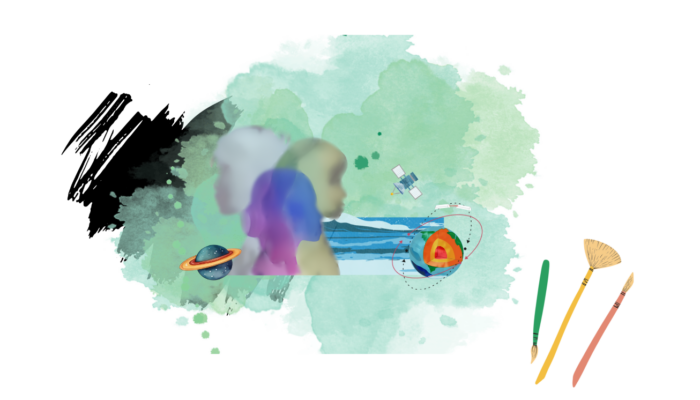
What does a geodesist look like? And what happens if you don’t “look the part”? Today, Franck Ghomsi, a Black African scientist, takes us along on his journey between South Africa, Canada and Cameroon. Franck does not only research the impact of climate change on coasts with geodetic techniques, but at the same time became an expert in self-motivation, battling racism and fighting against the windmills of visa acquisition.
Hi Franck, thank you for sharing your story with us and the geodesy community! First, can you give us your ‘classical work intro’ so that we get an idea of where you are working and what your field of interest is?
I’m currently a postdoctoral fellow and research staff in the Department of Oceanography at the University of Cape Town (South Africa) and at the Centre for Earth Observation Science (CEOS) at the University of Manitoba (Canada). My research focuses on sea-level variability and ocean heat budgets along African coastal Large Marine Ecosystems (LMEs) and across Antarctica, using both in situ observations and satellite altimetry. I am also a researcher at the National Institute of Cartography, under the Ministry of Scientific Research and Innovation in Cameroon. Broadly, my work seeks to understand how Earth dynamics— such as gravimetry, ocean processes, and climate variability—shape coastal environments, sea state, and crustal structure, with a particular emphasis on Africa and the polar regions. Ultimately, my goal is to generate knowledge that can support adaptation strategies to help coastal communities manage the combined effects of land subsidence, rising sea levels, and changing ocean conditions, and their impacts on marine ecosystems, thereby informing policy decisions. This focus is particularly critical in the Global South, where communities are not only among the most vulnerable but also suffer from a scarcity of in situ data and a lack of global attention.
How do you explain to your friends and family what you are doing as a job?
I usually tell my friends and family that I study the ocean and the Earth the way a doctor checks a patient’s health. I look at how the ocean is rising, warming, and changing over time. I also study how the Earth’s crust and the deep layers move and shift in places like the African rift systems. From Africa to Antarctica, my work is about understanding how the Earth and ocean are “feeling” and why they change, so we can better protect coastal communities, people in tectonically active regions, and the ecosystems.
Do you have any work-related habits or anything you do that you cannot work without (e.g. coffee, music, …)? Are there any other quirks we should know about?
Music and inspiration are at the heart of how I work. I usually start my mornings with a big cup of black coffee and music from artists like Richard Bona (Muntula Moto – The Benediction of a Long Life), Burna Boy (For My Hand), or Bobby McFerrin (Don’t Worry Be Happy), which helps me set a positive tone for the day. On Mondays, I wear African traditional shirts—a small ritual that brings cultural pride and roots energy into my research. On my desk, I keep two quotes from women who inspire me. One is from Wilma Rudolph: “Never underestimate the power of dreams and the influence of the human spirit. We are all the same in this notion: The potential for greatness lives within each of us.” The other is from Katherine Johnson: “Do your best. But like it! Like what you do; then you will do your best.” Their words remind me to push through difficulties, trust my path, and keep pursuing my dreams, especially coming from Africa, where fields like mine can sometimes feel distant or underdeveloped.
Would you like to share a bit about your background? For example, what and where did you study, and how did you get here? Is there anything that you are particularly passionate about?
Since I was about eight years old, I’ve been fascinated by the sky. I remember wondering why the moon seemed to follow me at night or why the sun never stopped moving. One day, while reading a cartoon book, I came across a comment about the moon’s role in the tides. At that time, I had never seen the ocean or visited a coastal city, so the idea that the moon could move water felt magical. Around the same time, news of volcanic eruptions in Cameroon and their devastating impacts struck me deeply, especially since early warning systems were lacking and remain insufficient for local communities. These early experiences sparked a lasting curiosity about the hidden forces shaping our planet, laying the foundation for my journey into geophysics and later, oceanography.
That curiosity deepened when I began my bachelor’s degree at the University of Yaoundé Ⅰ in Cameroon. During my first master’s years, I chose Geophysics and Geoexploration, and I still remember the joy I felt when geodesy was introduced in class—it felt like I had found my calling. After my first year of master’s studies, I was fortunate to receive international funding to study Physical Oceanography at the University of Paul Sabatier in Toulouse, France, in partnership with the University of Abomey-Calavi in Benin. I embraced the opportunity fully, earned my degree, and returned to Cameroon to complete my master’s in geophysics, ultimately graduating with degrees in both fields.
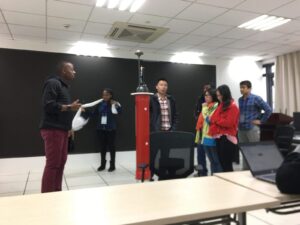
ARGO float calibration in china at a summer school during Franck’s master degree (Image credit: Franck Ghomsi)
Combining these two disciplines gave me the determination to keep pushing forward. That drive led me to pursue a dual PhD—one in Geophysics at the University of Yaoundé Ⅰ (started in September 2017) and another in Physical Oceanography at the University of Cape Town (started in November 2021) under the supervision of the late Mathieu Rouault followed up later by Babatunde J. Abiodun, which was made possible by a bursary from the Nansen Scientific Society through the Nansen Fellowship (via Ola M. Johannessen) and the Nansen-Tutu Centre, with significant contributions from researchers at the NERSC in Norway (especially Antonio Bonaduce and Roshin P. Raj) and DGFI-TUM in Germany, whose work was supported by the TUM.Africa Talent award. Completing both seemed almost impossible to many around me, but it was the natural extension of the passion I had carried since childhood.
At the heart of it all, my motivation is simple: to understand how Earth and ocean dynamics interact, and how these processes shape the future of our coasts and climate.
In the introductory post we mentioned an image of the “typical geodesist”. How many geodesists do you know who differ from that image? In what ways do you feel not represented by that image? Do you feel as a part of the geodetic community?
Personally, I know many geodesists, and fortunately, a significant number are women, such as Rebekka Steffen, Anny Cazenave, Julienne Stroeve and Annette Eicker. Along with experts like Babatunde J. Abiodun and Roshin P. Raj, none of them fit the “typical scientists” stereotype. I also don’t see myself in that description. There’s often an expectation that geodesists should be predominantly from Western countries and exceptionally brilliant, an image that can make the field feel unapproachable for newcomers from elsewhere. Coming from Africa, where geodesy is often seen as distant, overly complex, or lacking expertise, this stereotype feels especially alienating. At home, scientists are sometimes considered eccentric, which widens the divide. It’s also striking how few Africans appear on major panels. The discipline remains dominated by Western voices, and the strong focus on American and European journals and programs can reinforce inequalities, with excellent research from other regions often struggling for visibility.
Were there any situations where you felt excluded, not heard, made feel small or uncomfortable in any way for reasons of your identity, looks, origin or background?
At times, I’ve felt excluded or underestimated because of my identity. My Black skin, African origin, and accent in English or French sometimes mark me as an outsider. In international conferences, I’ve sensed subtle skepticism, as if meaningful contributions weren’t expected from someone with an African background. Racism also appears in small, everyday ways.
One of the most frustrating barriers has been obtaining visas. African passports rarely grant easy access to Europe, North America, or Australia, meaning repeated applications, high costs, and sometimes outright denials. For example, I was denied a visa to attend the recent IAG Scientific Assembly in Rimini (Italy), where I was supposed to convene a session. Simply being African can feel like a barrier.
Despite these challenges, I draw strength from figures like Wilma Rudolph and Katherine Johnson, whose stories inspire me to resist stereotypes and stay confident. A telling experience was a manuscript I co-authored with other Global South colleagues, which was initially rejected for “poor English.” Later, with the addition of a European co-author, the exact same paper was accepted, exposing biases in our field.
Ultimately, while these stereotypes and barriers are real, I am proud to be part of the geodetic community. By sharing my experiences, I hope to help broaden the image of who can be a geodesist and encourage more diverse voices, especially from Africa, to join and contribute to our field.
When you think about a couple of decades from now on, what do you think the geodetic community will look like? Do you have any suggestions for changes that could help break the stereotype?
Looking a couple of decades into the future, I hope the geodetic community will be far more diverse and inclusive than it is today. I imagine a field where people of all genders, ethnicities, backgrounds, and abilities are visible, supported, and celebrated, not as exceptions, but as the norm. Ideally, we’d see more geodesists from Africa, Latin America, Asia, and other historically underrepresented regions leading research, convening panels, and contributing to shaping the direction of our discipline. I also hope to see more international conferences held in underrepresented regions, particularly in Africa, where the continent is often stereotyped as defined by conflict, hunger, or insecurity. Hosting conferences locally would challenge these misconceptions and improve access to science and data in regions that currently have limited in situ measurements.
To break the stereotype, a few deliberate changes are needed. First, mentorship programs that actively support early-career scientists from underrepresented regions or groups would make a huge difference – an impact I experienced firsthand through the invaluable support of the Nansen Fellowship (NANSI) since 2016, POGO-SCOR fellowship, the TUM.Africa Talent award, Canada’s C150 Research Program, and Schmidt Sciences, LLC. A crucial aspect of such programs is visibility: showcasing diverse role models in talks, panels, journals, and online platforms helps challenge the outdated “typical geodesist” image. Second, structural barriers such as visa restrictions, conference costs, and the overemphasis on Western journals must be addressed, as they disproportionately affect researchers from developing countries. Third, we should foster a culture where alternative paths and approaches, whether in education, research methods, or career trajectories, are recognized and valued, rather than expecting everyone to conform to a narrow standard.
Finally, stories matter. Sharing personal journeys, like mine as a Black African scientist navigating both geophysics and oceanography, can inspire others to see themselves in geodesy and help create a community that truly reflects the global society it serves.
Thank you Franck for your openness, taking us on this deep dive through your experiences! We hope that people feel represented by your story, or inspired to make a change and contribute to a more diverse scientific community.
Do you also have a story to tell? Contact our team via this form to share your story. No strings attached!
– Edited by Marius Schlaak, Rebekka Steffen and Öykü Koç

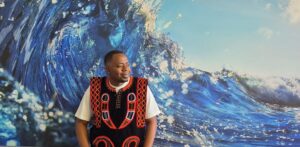
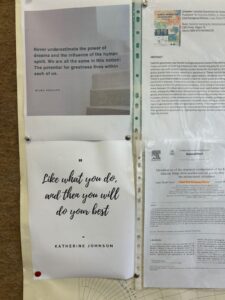
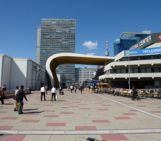
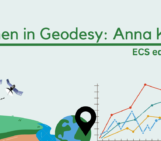
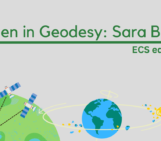
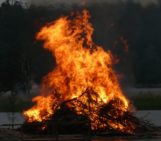
Bakoa Paul
Félicitations Dr Franck eitel Ghomsi
AZANGUIM ZANGUE
Toute science qui se veut élitiste est exclusive. Celui qui montre le chemin avec une torche à la main est vue de face avec le visage scintillant produits par la réflexion de la lumière est souvent vue comme personne dans la joie et sans difficulté l’ombre de son dos se cache les coûts de la vie, mais le plus dure à supporter se trouve dans la pénombre des regards agissant des habitants de la maison de la science auquel on appartient.
Chaque difficulté porte en elle un succès à découvrir grâce à l’effort que l’on met pour en venir à bout. Le plus important à savoir et qui nous est révélé par ton histoire M. Franck Ghomsi c’est que les difficultés s’enchaînent sans jamais s’arrêter et c’est ça la beauté de vie.
La lecture de cette histoire montre un homme qui a de la joie dans ce qu’il fait, donc cette histoire aura un impact plus grand que celui attendu, il suffit juste de se soumettre à l’exercice de lecture.